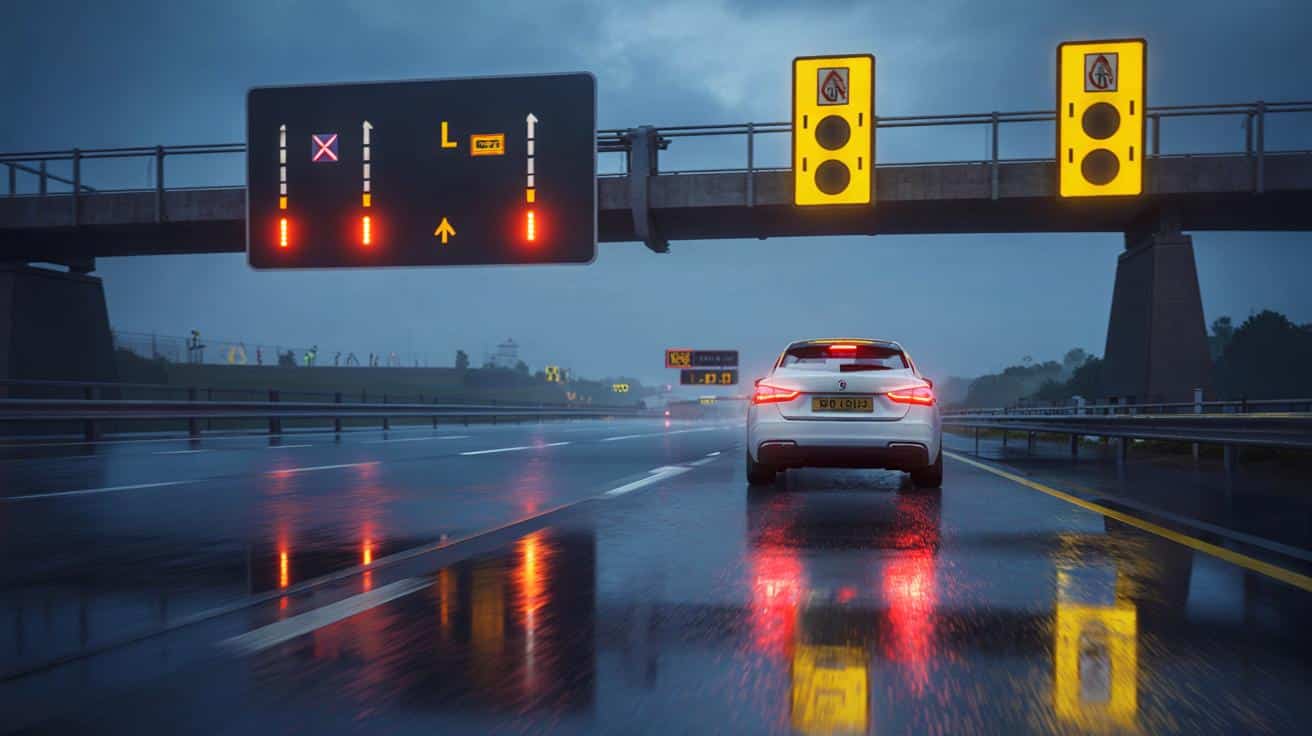A routine weekday on the M4. Dry tarmac, light spray in the air, gantry signs glowing their quiet instructions. Then a ticket. A fine. A driving ban — for 68mph. It sounds absurd at first glance, which is exactly why it’s set so many teeth on edge.
Cars slide in bunches, free for a mile, then slowed by a ripple of brake lights you can’t quite trace. I sit a lane over from a white saloon, its driver’s shoulders hunched, eyes darting between the road and the overhead signs.
The rain on the windscreen feels like a metronome. He holds 68mph, steady as a heartbeat, the sort of number that usually keeps you safe. The sign above flickers to 50. He doesn’t see it. Or can’t. Or thinks it’s for someone else. The camera doesn’t wink. It just watches. The camera doesn’t care about your calendar.
In the post, weeks later, comes the notice: fine, points, and then the bigger blow — a ban for totting up. Sixty-eight.
A ban at 68mph: how does that happen?
Most of us carry the old motorway truth in our bones: 70mph is the line, 60 in a van, keep it neat and you’re fine. But the M4 is a different animal when the signs light up. Variable limits and roadworks bring the ceiling down, lane by lane, minute by minute. What was comfortable a mile back can turn illegal in a blink. That’s the gap where drivers get caught.
Picture a mid-morning run through a roadworks stretch near a big junction. The overhead gantry sets a 40mph limit to protect a crew behind cones you barely register at speed. You drift through at 68mph because you’re late, or because the car in front is doing exactly that. The average speed cameras don’t flash; they measure you quietly from A to B. Weeks later, the letter lands, and it’s not just a small number. It can be six points for that single offence. If you had points already, a ban follows.
The law is blunt but consistent: it’s not the national limit that matters in that moment, it’s the limit shown. Breaking a variable or temporary limit is no different in the eyes of a magistrates’ court than speeding anywhere else. The sentencing bands scale with how far over you were. At 68mph in a 40mph stretch, you’re deep into the upper tier. That’s hefty points, a means-tested fine, and if your licence already looks tired, disqualification. It feels harsh because 68mph sounds normal, yet in a 40, it’s not.
What drivers can do right now
Give yourself a margin under the gantry number, not over it. Read the signs two gantries ahead if you can, scanning like you would for brake lights in the distance. Use speed limiter or adaptive cruise to cap your speed by a few mph, not to nail it right on the line. Treat lane-specific signs as gospel, because they are. And when the limit drops, lift off first, brake second. Smooth beats sudden — and it buys you time.
Trust the gantry, not the sat-nav. Navigation apps lag behind live controls, and smart motorways change faster than a map update. Don’t chase a pack just because it “feels” like the flow. We’ve all had that moment when the lane next to us looks like the right pace and we tuck in for comfort, not clarity. Night-time isn’t a free pass, and empty lanes don’t erase rules. Let’s be honest: nobody really does that every day.
There’s also the quiet discipline that helps when life gets noisy. Keep the dash uncluttered so your eyes can find the limit quickly. Check the mirrors before you check your phone in a lay-by, not while rolling. Little rituals add up to fewer near-misses. Small, boring habits stop big, expensive mistakes.
“If the sign says 50, it means 50 now — not in half a mile,” a former traffic officer told me. “By the time you see the cones, you’re already late to the decision.”
- Look two gantries ahead and name the limit in your head.
- Set a limiter 3–5mph under the posted number to create a buffer.
- Watch for lane arrows and red X signals; they’re enforceable.
- Ignore sat-nav limits when they conflict with live signs.
- On average speed sections, keep it steady between cameras, not just at them.
The bigger picture
There’s a deeper itch here about fairness. Getting banned at 68mph doesn’t match the way we talk about motorways around the dinner table, or the way a clean stretch of the M4 looks at 10am on a Tuesday. But justice in traffic court isn’t about vibes; it’s about the number on the sign and the story on your licence. That gap between feeling and rule is where frustration lives, and where road safety policy tries to steer us back toward patience.
Drivers aren’t daft. People know when they’ve pushed their luck, and when they’ve simply missed a signal in the visual soup of modern roads. Smart motorways were built to make things safer and smoother, and some days they do. On other days, they feel like a test you didn’t revise for. Maybe the lesson isn’t to become perfect readers of flashing signs, but to build a little more slack into the way we drive and the way our roads talk to us. Space to notice. Space to breathe. Space to get home.
| Key points | Detail | Reader benefit |
|---|---|---|
| Why 68mph can lead to a ban | Variable and temporary limits on the M4 make 68mph illegal in 40 or 50 zones; one offence can add six points, triggering disqualification if you’re near 12 | Understands how a “normal” speed becomes a high-tier offence and why the court acted |
| How to read smart motorway signs | Scan two gantries ahead, prioritise lane-specific symbols, and set a small buffer with a speed limiter over relying on sat-nav limits | Reduces the chance of missing a change and getting an unexpected ticket |
| What sentencing looks like | Magistrates use banded guidelines based on your speed and the set limit, plus your history; fines are income-based and bans can be immediate | Knows what to expect if summoned, and the levers that influence outcomes |
FAQ :
- Can you really be banned for 68mph on a motorway?Yes, if the motorway limit at that moment was below 68mph, such as a 40 or 50 zone. The offence can carry enough points to push you over 12 within three years, which triggers a totting-up ban.
- What happens if I miss a variable speed limit sign?The limit still applies. Courts assess the posted limit and your recorded speed, not whether you noticed the sign. Clear signage and working gantries are assumed unless you can show evidence to the contrary.
- Do average speed cameras allow a margin?Enforcement tolerances exist but aren’t a cushion to lean on. Average systems calculate your speed between cameras, so brief braking at the camera won’t help if your overall pace is over the line.
- Will my sat-nav limit protect me if it shows 70?No. Live roadside signs override whatever the sat-nav says. Maps often lag behind temporary or variable changes on smart motorways like the M4.
- Can I challenge a ticket from a smart motorway?You can contest if there’s a genuine issue: wrong vehicle, faulty signage, or camera error. Gather evidence — dashcam footage, photos, timing — and seek legal advice before pleading.








